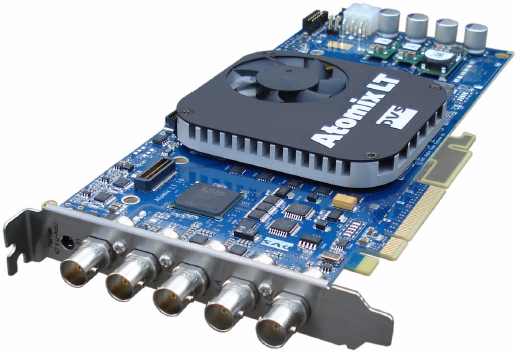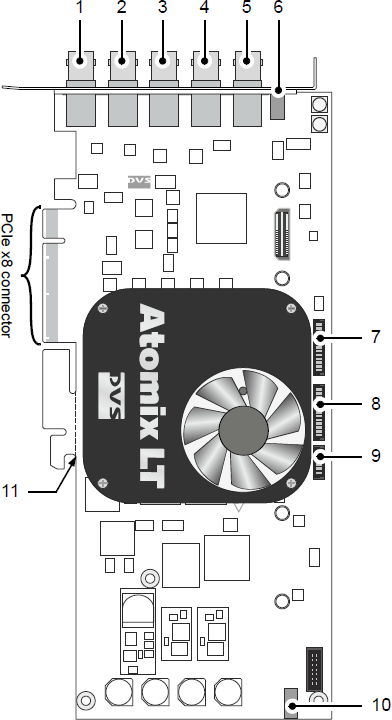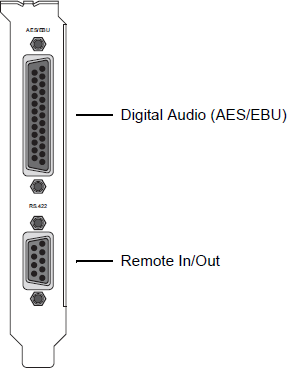
Viz Engine Administrator Guide
Version 3.14 | Published March 10, 2021 ©
DVS Atomix LT

This section contains a description of the Digital Video Systems’ (DVS) Atomix LT video board. Atomix LT is designed for HD TV broadcast and film post production up to 2K. Atomix LT features two video channels that can be used independently or in 3D/stereo mode up to 2K. Moreover, it has an up/downscaler, a 1D LUT and multi-rate SDI ports with 3.0 Gbps which can be used in various single- and dual-link configurations.
Use of the DVS is mainly used with Viz Virtual Set and Viz Arena, and is Vizrt’s successor of the DVS Centaurus II. The DVS Atomix LT is as with the Centaurus II able to output SD, HD and 2K. The DVS Atomix is typically mounted in HP Z800 machines.
This section contains information on the following topics:
Connectors
Overview of the Items and Connectors on the DVS Atomix LT Board

This section is an excerpt from the DVS Atomix LT installation guide (version 1.0) section 2.2.1 and 2.3.2: Overview of the Component Side and Audio _and RS-422 Panel_. For complete information, please refer to DVS’ installation guide available for download on their website.
|
No. |
Item |
Explanation |
|
1 |
SDI Out B |
BNC connector for an output of digital video signals (serial digital interface, port B); usually used for an output of the second video channel in single-link (YUV) or dual-link modes (3-Gbit/s SDI); can also be used for the first video channel for the second dual-link stream of YUVA or RGB[A] |
|
2 |
SDI Out A |
BNC connector for an output of digital video signals (serial digital interface, port A); usually used for an output of the first video channel in single-link (YUV) or dual-link modes (either 3-Gbit/s SDI or first dual-link stream of YUVA or RGB[A]) |
|
3 |
SDI In B |
BNC connector for an input of digital video signals (serial digital interface, port B); usually used for an input of the second video channel in single-link (YUV) or dual-link modes (3-Gbit/s SDI); can also be used for the first video channel for the second dual-link stream of YUVA or RGB[A] |
|
4 |
SDI In A |
BNC connector for an input of digital video signals (serial digital interface, port A); usually used for an input of the first video channel in single-link (YUV) or dual-link modes (either 3-Gbit/s SDI or first dual-link stream of YUVA or RGB[A]) |
|
5 |
Ref In |
BNC connector for the reference input |
|
6 |
Fail Safe 0 |
See Fail Safe 1 |
|
7 |
AUDIO 1-8/LTC |
Flat cable connector for analog audio, the digital audio channels 1 to 8 and LTC |
|
8 |
AUDIO 9-16 |
Flat cable connector for the digital audio channels 9 to 16 |
|
9 |
RS-422 A/B |
Flat cable connector for an in- and output of RS-422 signals (main remote ports) |
|
10 |
Fail Safe 1 |
For a bypass of the SDI input signals to the SDI outputs in case of power loss connect to either this connector or Fail Safe 0 a rechargeable battery (accu, see section “Technical Data” on page A-1) |
|
11 |
Breaking line |
The printed circuit board provides at its bottom an extension void of any electrical parts; it may serve to stabilize the installation of the board in a computer system; when not needed or interfering, you can carefully break it off the circuit board at the breaking line |
Panel with Audio and Remote Control Connections

With the board you also have the breakout cable, RS-422 panel and cable. On the RS-422 panel there are two connectors, one DB-25 connector for digital audio (AES/EBU) and one DB-9 connector for remote in/out.
|
Item |
Explanation |
|
Digital Audio (AES/EBU) |
DB-25 connector (female) for audio and LTC in- and output; provides either four stereo channels digital audio (channels 1 to 8) or three channels audio plus LTC; alternatively it can be used to provide the digital audio channels 9 to 16. |
|
Remote In/Out |
DB-9 connector (female), serial RS-422 interface for master or slave control. |
The breakout cable has four XLR male and four XLR female connectors to interface directly with audio devices. The RS-422 panel’s cable is mounted on the back of the RS-422 panel’s board and connected to the Atomix LT board.
Supported Codecs
Currently, the DVS implementation only supports the Microsoft DirectShow Filtergraph framework to render video clips. This enables you to play for example MPEG files or streams from a server.
For more information on how to use video clips in Viz Artist, see the Viz Artist User Guide, in particular the SoftClip and MoViz plug-ins.
Basically, the DVS board can play everything that can be played out by the Windows Media Player, so it depends on what codecs/DirectShow filters that are installed on the machine.
Configuration History for DVS
The following driver versions are supported:
|
Viz Release |
Driver Version |
|
3.5.4 and later |
SDK 4.3.5.10 |
|
3.5.2 - 3.5.3 |
SDK 4.2.9.8 |
|
3.3.0 - 3.5.1 |
SDK 4.0.1.15 |
For information on how to install or update the driver, please refer to DVS’ SDK 2.7 user guide (version 2.0) sections 3.2 and 3.3: Installation under Windows and Updating an Existing SDK.
Licensing
For information on how to set the license key for your DVS Atomix LT board, please refer to the DVS Atomix LT installation guide (version 1.0) section 3.3: Setting the License Key.
See Also